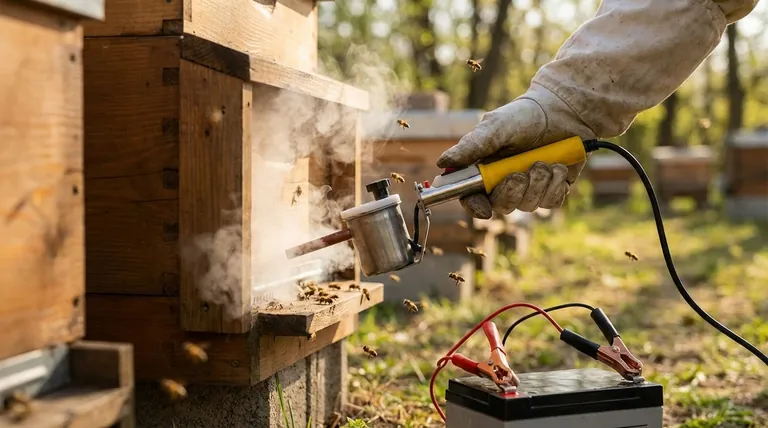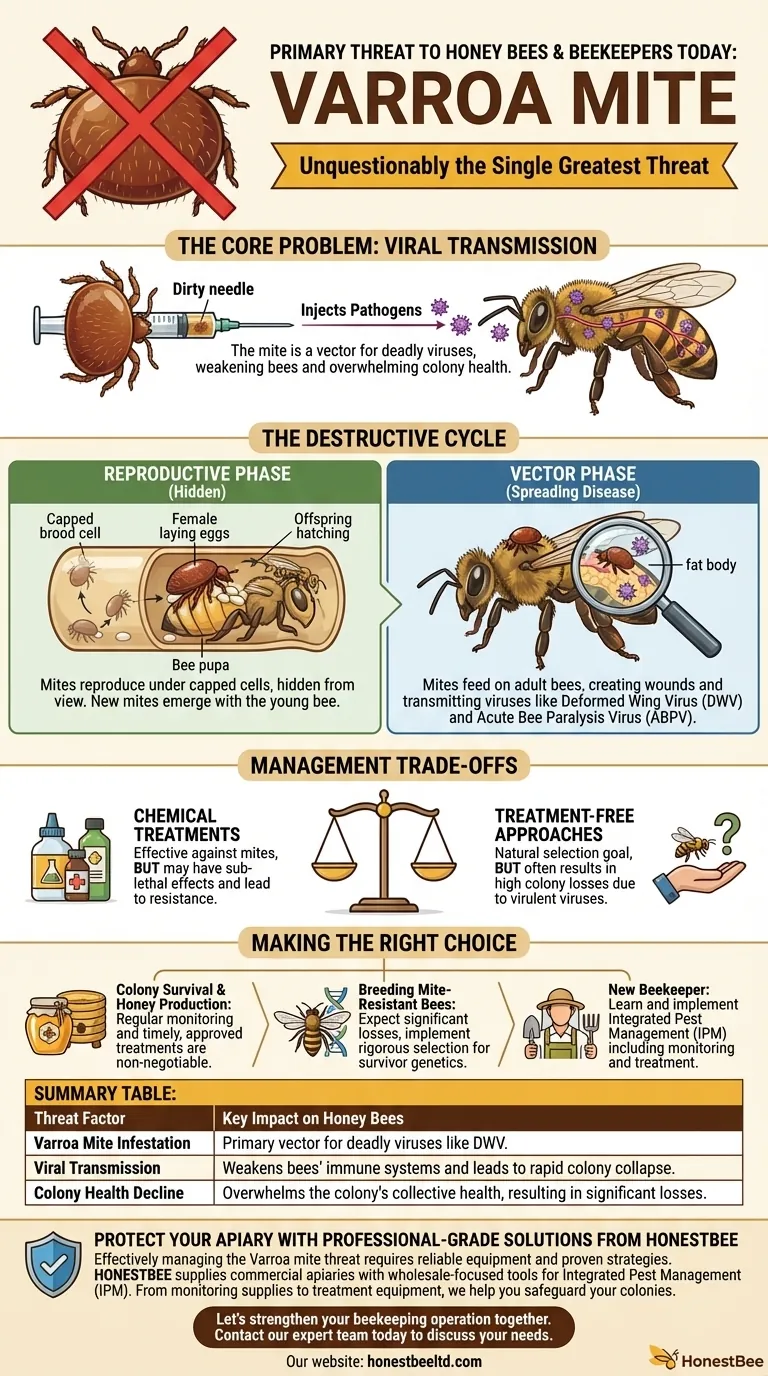Unquestionably, the single greatest threat to honey bees and beekeepers worldwide is the parasitic Varroa mite. This external parasite, specifically Varroa destructor, is not just a pest; it is the primary vector for a host of devastating viruses that can collapse an entire honey bee colony.
The core problem is not the mite itself, but the deadly viruses it transmits. A Varroa mite acts like a dirty needle, injecting pathogens directly into the bee's circulatory system, weakening the individual bee and overwhelming the colony's collective health.

The Destructive Cycle: How Mites Overwhelm a Colony
The Varroa mite's life cycle is perfectly synchronized with that of the honey bee, making it an incredibly efficient parasite. Understanding this cycle reveals why it's so difficult to control.
The Reproductive Phase: Hidden from View
Varroa reproduction occurs entirely underneath the capped cells of developing bee pupae.
An adult female mite will enter a brood cell just before the worker bees cap it with wax. Once sealed inside, she lays her eggs.
The offspring hatch, mate with each other, and feed on the developing bee pupa. By the time the young adult bee emerges from its cell, several new, mated female mites emerge with it, ready to infest other bees and repeat the cycle.
The Vector Phase: Spreading Disease
Once attached to an adult bee, the mite feeds on its "fat body" tissue, which is a vital organ responsible for immune function, detoxification, and energy storage.
This feeding action creates open wounds and directly transmits viruses, such as Deformed Wing Virus (DWV) and Acute Bee Paralysis Virus (ABPV).
A colony with a low mite count can often tolerate the physical damage. However, once the mite population grows, the viral load explodes, leading to a rapid decline in the colony's health.
Understanding the Trade-offs in Mite Management
Controlling Varroa is a constant battle for beekeepers, and every treatment option comes with significant trade-offs. There is no perfect, "set it and forget it" solution.
The Challenge of Chemical Treatments
Many chemical miticides (known as varroacides) are effective at killing mites. However, they can have sub-lethal effects on bees, impacting queen fertility and colony development.
Furthermore, mites can develop resistance to these chemicals over time, rendering treatments ineffective and forcing a rotation of different chemical families.
The Limitations of "Treatment-Free" Approaches
Some beekeeping philosophies advocate for avoiding all treatments, hoping that natural selection will produce mite-resistant bees.
While a worthy long-term goal, this approach often results in the death of the majority of colonies. The viruses spread by the mites are simply too virulent for most bee populations to overcome without assistance.
Making the Right Choice for Bee Health
Your approach to managing this threat depends on your goals as a beekeeper and your commitment to proactive monitoring.
- If your primary focus is colony survival and honey production: Regular monitoring of mite levels and timely, approved treatments are non-negotiable.
- If your primary focus is breeding mite-resistant bees: Be prepared for significant colony losses and implement a rigorous selection process to propagate survivor genetics.
- If you are a new beekeeper: The most responsible path is to learn and implement an Integrated Pest Management (IPM) plan that includes monitoring and treating for Varroa mites.
Ultimately, managing Varroa mites is the central challenge of modern beekeeping, demanding vigilance, education, and proactive intervention.
Summary Table:
| Threat Factor | Key Impact on Honey Bees |
|---|---|
| Varroa Mite Infestation | Primary vector for deadly viruses like Deformed Wing Virus (DWV). |
| Viral Transmission | Weakens bees' immune systems and leads to rapid colony collapse. |
| Colony Health Decline | Overwhelms the colony's collective health, resulting in significant losses. |
Protect Your Apiary with Professional-Grade Solutions from HONESTBEE
Effectively managing the Varroa mite threat requires reliable equipment and proven strategies. HONESTBEE supplies commercial apiaries and beekeeping equipment distributors with the wholesale-focused tools needed for effective Integrated Pest Management (IPM). From monitoring supplies to treatment equipment, we help you safeguard your colonies and your livelihood.
Let's strengthen your beekeeping operation together. Contact our expert team today to discuss your needs.
Visual Guide

Related Products
- 12V Bee Mite Removal Evaporator Oxalic Acid Vaporizer for Bee Fumigation Treatment 180W Atomization
- Adjustable Formic and Acetic Acid Dispenser for Bee Mite Treatment
- Professional Bamboo Queen Isolation Cage
- Metal Queen Bee Excluder for Beekeeping
- Premium Wood Framed Metal Wire Queen Bee Excluder
People Also Ask
- Why is oxalic acid not used in summer? Timing is critical for effective Varroa mite control.
- What are the supposed benefits of fogging oxalic acid over the dribble method? Speed, Coverage, and Bee Safety
- What are the registered application methods for oxalic acid in beekeeping? Choose the Right Varroa Mite Treatment
- What is the overall goal of using oxalic acid in late fall for beekeepers? Maximize Winter Survival with a Broodless Treatment
- What is the role of oxalic acid in plants? A Key to Plant Defense and Internal Regulation



















